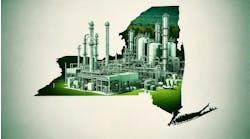While it's a little more time consuming, a plant-wide assessment approach yields better results compared to a piecemeal approach — more than justifying the extra effort and resources. In this case study, Formosa Plastics Corporation, U.S.A. partnered with the U.S. Department of Energy (DOE) to assess the energy efficiency of the company's linear low-density polyethylene (LLDPE) plant in Point Comfort, Texas.
[pullquote]
The plant manufactures polyethylene pellets for downstream customers that produce plastic consumer products. The primary production process is polymerization, converting ethylene into useful and stable polyethylene pellets. Four process units carry out production: namely, the catalyst preparation unit, prepolymerization unit, polymerization unit and the additives and pelletizing unit. The process requires electricity, water, natural gas, nitrogen and steam utilities.
Staff from the plant's operations and engineering departments and a consulting firm made up the energy assessment team. The consulting firm developed two decision tools for the assessment. The team used benchmark data to calculate sustainability metrics that identified the energy intensity (kWh required per pound of product) for each process area. They also calculated practical minimum energy (PME) or base-level energy requirements through a pinch analysis and a fluid-handling analysis to determine the minimum energy needed to compress and transfer liquids from one process to another. PME data also helped identify cost-benefit effects of implementing process improvements with investment criteria of 2–3-year payback.
The assessment revealed five projects that could save energy, increase productivity, and reduce waste and environmental emissions.
Upgrade the gas compressor impeller. The gas compressor that recovers ethylene discharged from the polymerization reactor along with polyethylene used a significant amount of energy. The assessment team recommended an open-type impeller design that would consume 14% less electricity than the existing closed-type impeller under the same operating conditions. The new impeller also would reduce potential polyethylene buildup, which can cause blockages and cut operating efficiency.
Improve the product transfer system. In studying the product transfer system's equipment and operation, the team identified that 14 blowers, with a combined rating of 3,500 hp, were used to transfer LLDPE resin through various process steps. Because these processes require a significant amount of electricity, the team suggested two steps: increase the transfer rate, and reduce the idle time between product transfers through production control and distributive control system monitoring. During the assessment, the first step was implemented immediately in one area. Reducing the idle time alone resulted in electricity cost savings estimated at $133,760/yr.
Improve extruder system heating. The first four sections of the extruder system are used to melt the powder fed into the extruder. An electric heating element with a water-cooling system maintains the correct melting temperature. The assessment team found that the cooling water flow and the heating element temperature weren't optimal, consuming more electricity and cooling. Hence, the team developed a better control plan for the heating element, reducing its temperature range, and upgrading the cooling water manifold.
Recover steam condensate. Steam provides the heat needed for the LLDPE production process. The plant originally was designed to discharge steam condensate into the cooling tower as a source of cooling tower makeup water. Water used to produce steam must be demineralized before it's fed to boilers or other steam-producing devices. After analyzing the pros and cons, the team recommended transferring steam condensate to the plant's waste-heat boiler for use as pure feed water makeup. This would save $56,000 annually, due to less use of pure feed water makeup for the boiler and natural gas. The project also reduced the amount of pure water required in the extrusion area.
Optimize the vent blower system. During a historical data review and field operation check of the system, the team found that a much smaller system would meet venting requirements. The newly installed, smaller vent blower system saves $35,840/yr in energy costs.
In total, the assessment identified potential fuel savings of 115,000 MMBtu and electricity savings of 14 million kWh for an annual cost savings of $1.5 million and means to increase productivity and reduce environmental emissions. The team also generated a list of PME standards for LLDPE processes.
Source: Project Fact sheet, Office of Industrial Technologies, Energy Efficiency, U.S. DOE
VEN V. VENKATESAN is Chemical Processing's Energy Columnist. You can e-mail him at [email protected]



